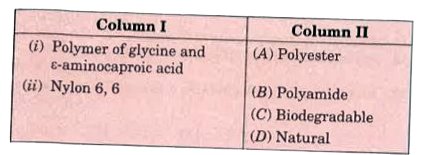Column -I Column -II
(A) Terylene (P) Condensation polymerization
(B) Stryrene (Q) Addition polymerization
(C ) Bakellite (R ) Homo polymer
(D) Teflon (S) Co-polymer
A-PS, B-QR, C-PS , D-QR
Topper's Solved these Questions
- BOOK - MOTIONCHAPTER - BIOMOLECULES & POLYMERSEXERCISE - EXERCISE - 4 (LEVEL I)26videos
BIOMOLECULES & POLYMERS
- BOOK - MOTIONCHAPTER - BIOMOLECULES & POLYMERSEXERCISE - EXERCISE - 4 (LEVEL II)17videos
BIOMOLECULES & POLYMERS
- BOOK - MOTIONCHAPTER - BIOMOLECULES & POLYMERSEXERCISE - EXERCISE - 2 ( LEVEL - II SECTION D)4videos
BIOMOLECULES & POLYMERS
- BOOK - MOTIONCHAPTER - ATOMIC STRUCTURE EXERCISE - EXERCISE-4 (LEVEL-II)18videos
ATOMIC STRUCTURE
- BOOK - MOTIONCHAPTER - CARBONL COMPOUNDSEXERCISE - EXERCISE - 4 LEVEL -II24videos
CARBONL COMPOUNDS
Similar Questions
Match the column :
Column -I Column -II
(A) Nylon-6, 6 (P) Condensation polymerization
(B) styrene (Q) Addition polymerization
(C ) Bakellite (R ) Homo polymer
(D) Teflon (S) Co-polymerView Solution1,3-Butadiene and styrene on polymerization give:
(A) Buna- S (B) Terylene (C) Buna-N (D) TeflonView Solution
Knowledge Check
- Question 1 - Select One
A : Polypropylene is an addition polymer.
R:Addition polymerization occurs among molecules which contain double bonds.AIf both Assertion & Reason are true and the reason is the correct explanation of the assertion, then mark 1.BIf both Assertion & Reason are true but the reason is not the correct explanation of the assertion, then mark 2.CIf Assertion is true statement but Reason is false, then mark 3.DIf both Assertion and Reason are false statements the mark 4. - Question 2 - Select One
Match the polymer (column I) with the class of polymer (column II)
 A(i)−(C),(ii)−(B)B(i)−(A),(ii)−(B)C(i)−(B),(ii)−(D)D(i)−(C),(ii)−(A)
A(i)−(C),(ii)−(B)B(i)−(A),(ii)−(B)C(i)−(B),(ii)−(D)D(i)−(C),(ii)−(A) - Question 3 - Select One
Polymers are made up of small molecules called monomers. Polymers which are formed by one type of monomer called homopolymers and which are formed by more than one type of monomers are called co-polymers. Natural polymers are biodegradable whereas systhetic polymers may or may not be. Addition or chain growth polymerization involves the repeated addition of monomers to the polymer chain. The monomers are unsaturated compounds and this type of polymerization takes placed by ionic (cationic or anionic) as well as free radical a series of condensation reactions between the monomers. Each monomer normally contains two functional groups. Branch chain polymers may be condensation polymers or addition but cross linked polymers are always condensation polymers.
Which one of the following polymers is prepared by condensation polumerization ?ATeryleneBTeflonCStyreneDRubber
Give one example each of
(i) addition polymers (ii) condensation polymers ,
(iii) copolymers .View SolutionGiving one example of each of :
(i) addition polymers
(ii) condensation polymers
(iii) copolymers.View SolutionSilicone polymers can be synthesized in liquid or gel or resin forms. There properties depend on
(A) the length of the polymeric chain
(B) the degree of polymerization and cross linking of the polymeric chains
(C) the degree of branching chains
(D) all of theseView SolutionExplain the following giving one suitable example in each case
(i) Elastomers (ii) Condensation polymers (iii) Addition polymersView SolutionPolymers are made up of small molecules called monomers. Polymers which are formed by one type of monomer called homopolymers and which are formed by more than one type of monomers are called co-polymers. Natural polymers are biodegradable whereas systhetic polymers may or may not be. Addition or chain growth polymerization involves the repeated addition of monomers to the polymer chain. The monomers are unsaturated compounds and this type of polymerization takes placed by ionic (cationic or anionic) as well as free radical a series of condensation reactions between the monomers. Each monomer normally contains two functional groups. Branch chain polymers may be condensation polymers or addition but cross linked polymers are always condensation polymers.
Which of the following is a chain growth polymer ?View Solution

